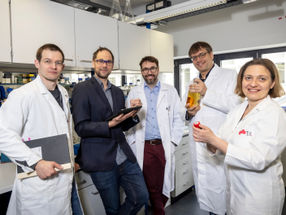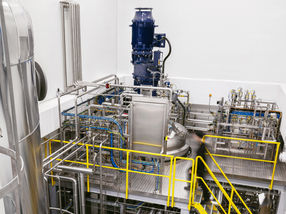"Drawing" with Nanoparticles
Defined patterns of gold nanoparticles in transparent materials - optoelectronic building blocks of the future?
19-Apr-2004
Small but impressive: nanoparticles are so tiny that they are somewhere between
individual atoms and "normal" solid particles. Their optical and electronic
properties are correspondingly intriguing. Collaborating Japanese and Chinese
researchers have now developed a method by which gold nanoparticles can be
deposited so precisely that it is possible to use them to "draw" colorful,
three-dimensional pictures in transparent materials.
However, the aesthetic, artistic aspect of this new technique is only a
secondary feature. Materials doped with nanoparticles of precious metals are hot
candidates for ultra fast optical switching elements in optoelectronics. The
need for a precisely defined spatial distribution of nanoparticles within the
material has thus far been a difficult hurdle. A team led by Jianrong-Qiu has
now overcome this obstacle. The starting material for this new method is a
silicate glass doped with gold oxide (Au2O3). When the glass is irradiated by a
laser beam, tiny grey dots form wherever the beam strikes the glass. In this
way, the researchers can "draw" an approximately 5 mm by 5 mm butterfly, in
sharp detail, in the glass. If the glass is then tempered at 550 °C, the grey
picture becomes colored; depending on the intensity of the initially implemented
laser beam, the butterfly turns purple, red, or yellow. They also observed that
the colour could be space-selectively deleted again by a second irradiation of
the laser.
How does this work? The extremely high energy input from the short laser pulses
causes electrons in the irradiated spots in the glass to separate from their
atomic nuclei. Gold ions are capable of absorbing such free electrons and are
thus reduced to gold atoms. The application of heat then gives the gold atoms
enough energy to separate from the silicate network and wander about. If they
bump into other gold atoms, they aggregate into tiny clumps. These gold
nanoparticles are colored because they absorb light in the visible range of the
spectrum. The wavelength of light absorbed depends on the size of the
nanoparticles. And the greater the intensity of the laser, the more reduced gold
atoms are formed per unit of volume. These atoms act as nucleating points.
heating thus produces a correspondingly larger number of correspondingly smaller
gold nanoparticles. A second laser irradiation breaks the nanoparticles into
tiny pieces or atoms.
This new technique could be an important step toward extremely fast
three-dimensional optical storage with very high storage capacity. In addition,
the team hopes to produce complete three-dimensional gold nanocircuits in
glasses with a high gold-ion content.
Most read news
Other news from the department science

Get the chemical industry in your inbox
From now on, don't miss a thing: Our newsletter for the chemical industry, analytics, lab technology and process engineering brings you up to date every Tuesday and Thursday. The latest industry news, product highlights and innovations - compact and easy to understand in your inbox. Researched by us so you don't have to.
Most read news
More news from our other portals
Last viewed contents
Balzan Price Ceremony 2007: 1 Mio. Swiss Francs for Nanoscience - Half of the amount must be destined to research projects
Go to page
Eastman, Hercules Reach Agreement on Resins Business Transaction
Go to page

Precisely arranging nanoparticles - Research team develops plasmonic molecules from nanoparticles
Go to page
Boehringer Ingelheim delivers marked increase in turnover and net income
Go to page
ASC's Drew Industrial purchase Finnan Engineered Products Ltd.
Go to page
McNeil Acquires St. Joseph® Business from Schering-Plough Healthcare Products
Go to page
MDS Sciex Signs Distribution Agreement with Advanced Labs for Australian and New Zealand Market
Go to page

Andreas & Thomas Schneider Maschinenbau GmbH - Bretzenheim, Germany
Go to page
Gen. James L. Jones Nominated to Chevron Board of Directors
Go to page
Solvay establishes Solvay Energy to manage energy purchases - New subsidiary will optimize net energy costs of Solvay Group
Go to page
BASF Antwerp: New superabsorbents plant starts operations
Go to page

Biomedical Service de México, S.A. de C.V. - México, D.F., Mexico
Go to page


























































